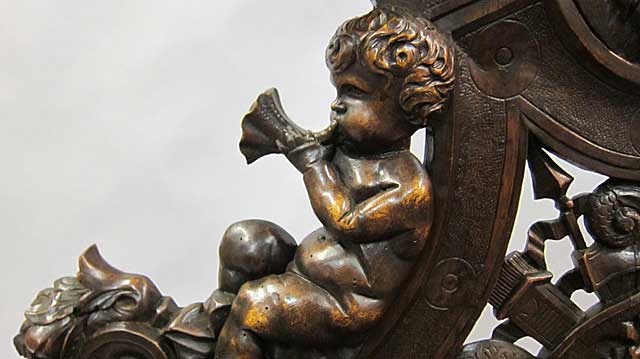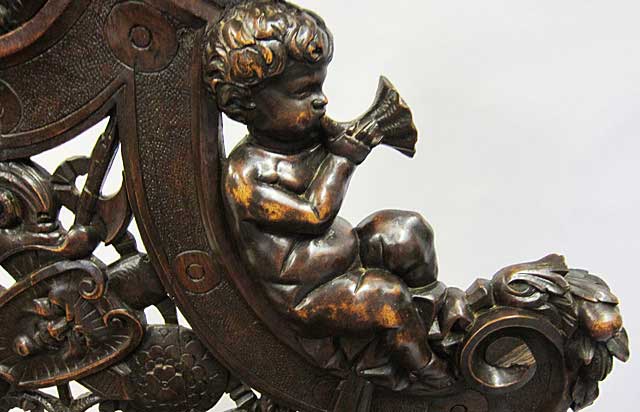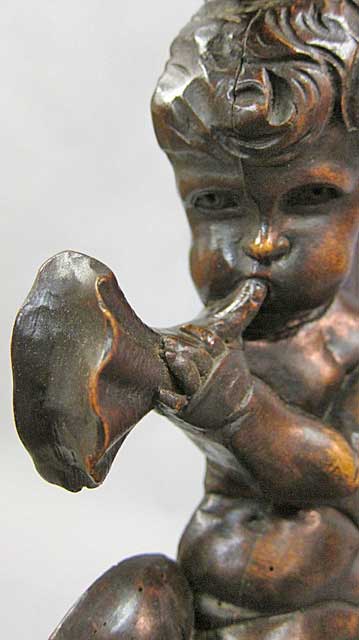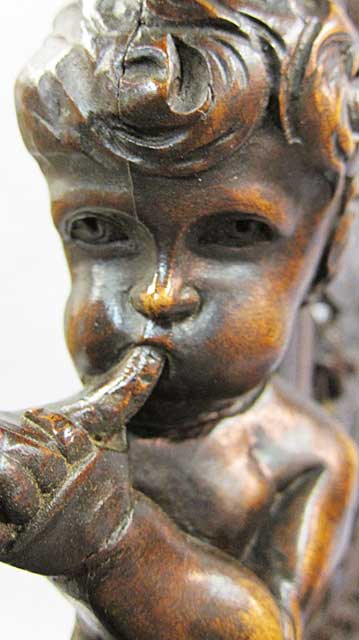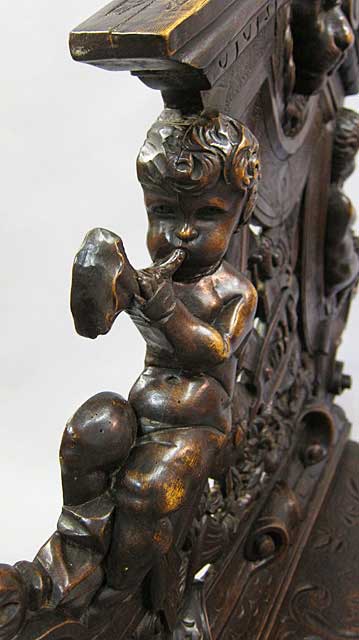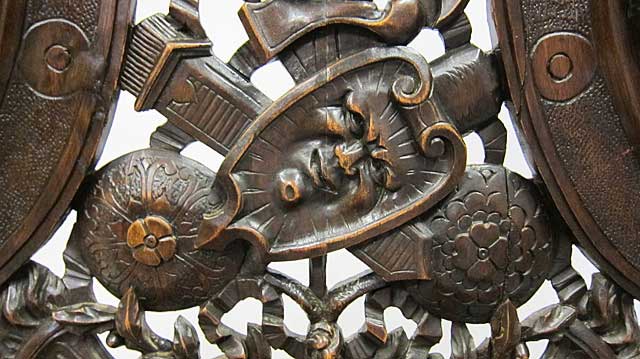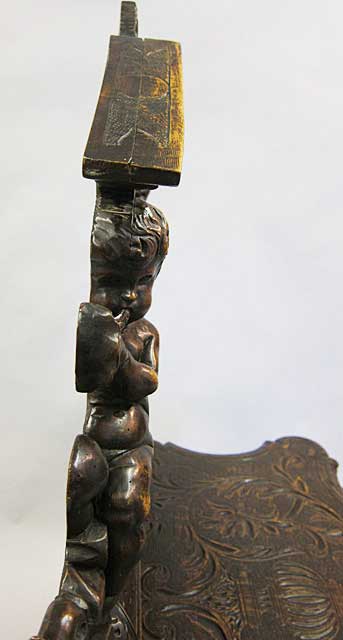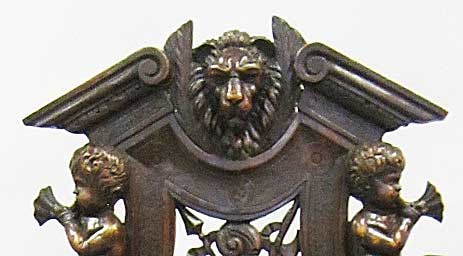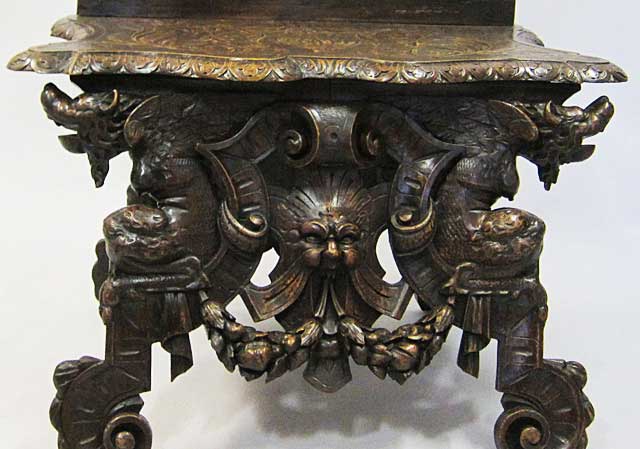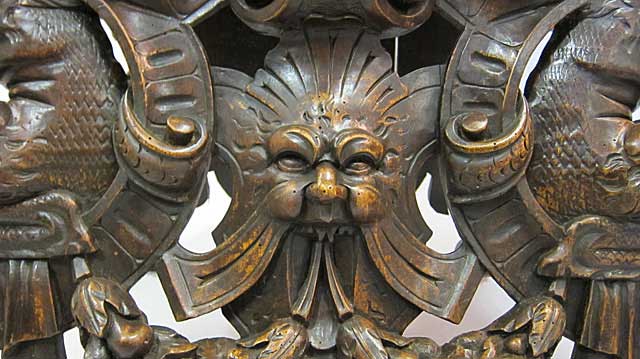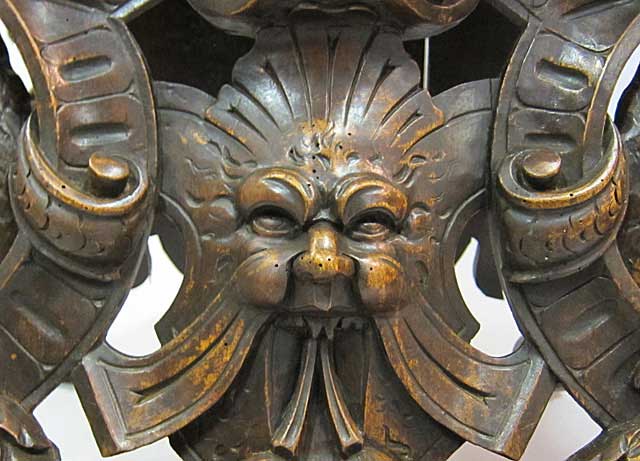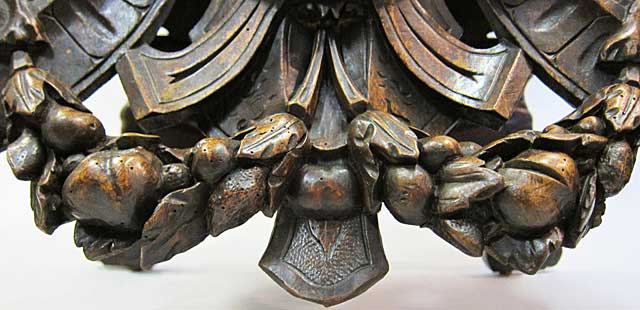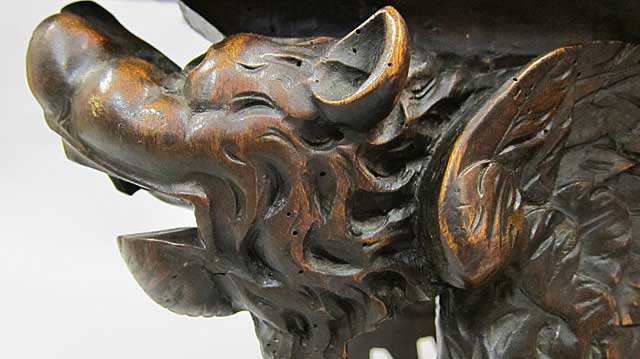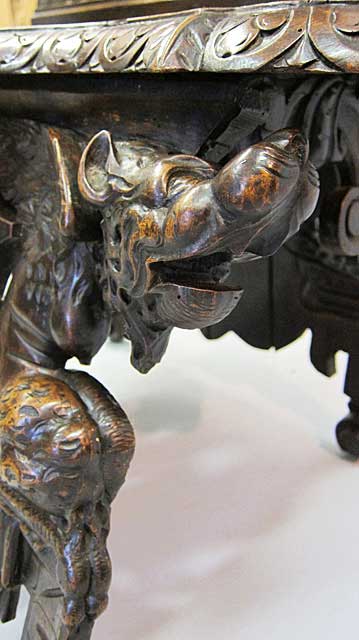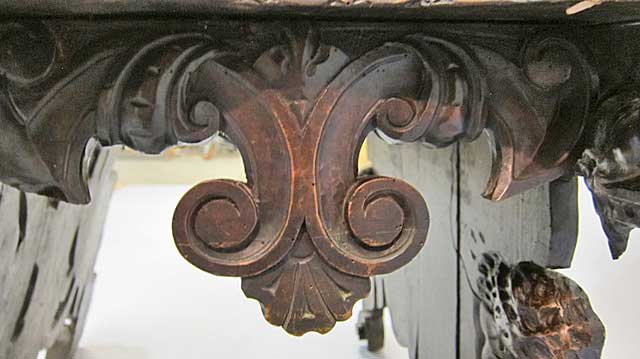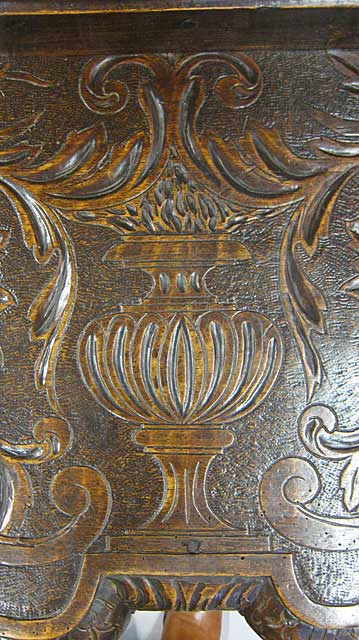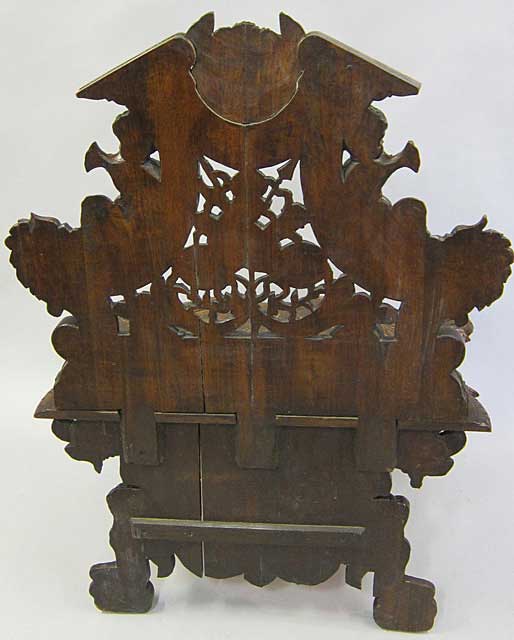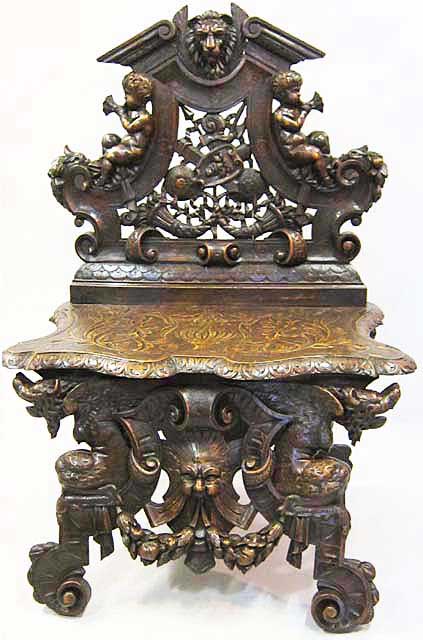
As a category of chair, the sgabello can be traced to Italy where it began life in the Renaissance period as an octagonal seat supported by solid boards, at front and back, tilting outward to provide stability. The seat being very tiny and, in the absence of a backrest, we doubt that the sgabello as originally designed was comfortable for sitting. Nevertheless, its popularity increased as it became the center of attention for elaborate carvings on the front and, eventually, the addition of a backrest that was also heavily carved. Typically used in pairs as decorative items rather than for seating, sgabelli with very wide seats, such as this one, are less common than the narrow chairs with the tiny seats.
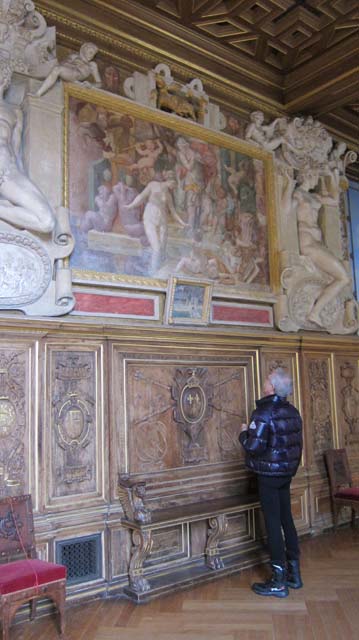
It is difficult to know how to start when describing this sgabello bench, so we will begin where its maker found his inspiration. It is evident that the creator of this bench, whose name is not known to us, was intimately familiar with the stuccoes designed by Rosso Fiorentino (1495-1540) for the Galerie François I at the Château of Fontainebleau. While we would like to imagine him spending hours (as we have) staring at Rosso's masterpieces, it may be that he knew the designs only through books of prints and engravings circulating among furniture designers in the 19th century when enthusiasm for reviving styles from the Gothic and Renaissance periods peaked. However he came by the elements of his design, the resulting sgabello is a masterpiece evoking the finest of the Italian Renaissance as interpreted in France in the 16th century and re-interpreted in the 19th century revival.
For information about Rosso's designs for Fontainebleau, we have relied on the authors listed in the Reference section, below, and in particular on the chapter about the Galerie François I in Eugene Carroll's comprehensive website dedicated to Rosso Fiorentino (link, below). It was on this chapter that Eugene was working when we last visited with him in April of 2016, a few weeks before his death. Eugene A. Carroll, PhD, was Professor Emeritus of Art History at Vassar College. His publications included a catalogue of Rosso's works for an exhibition at the National Gallery of Art in Washington, DC (see, below).
The Galerie is a long corridor with paintings (frescoes), surrounded by elaborate designs in stucco. The frescoes and stuccoes are above the magnificent walnut paneling that is at eye level. Conceived and executed by Rosso Fiorentino, aided by an army of assistants, at least three of the frescoes are believed to have been painted by the master. The frescoes tell various tales from mythology and ancient history, unified by the theme of François I as monarch and military leader of France. The stuccoes are Rosso's masterpieces of design and innovation.
More than mere frames, in some cases the stuccoes mirror aspects of the theme of the fresco they surround. But mainly, they are three-dimensional celebrations of Renaissance design with elements spilling over into the viewer's space. Their life-size figures seem to pull us into the drama of the fresco while propelling us from one scene to the next down the vast length of the Galerie.
Decorative elements of the stuccoes include garlands and baskets of fruit and flowers, acanthus leaves (whether in isolation or forming part of the hair, beard or ears of masks), putti (chubby male children with wings), herms (busts atop vertical pillars), nudes (male and female), centaurs, dogs, heads of lions and rams, vases, strapwork (cuir découpé), scrollwork, drapery, grotesque masks (including in profile and within a semicircle), and various symbols related to King François I (the letter "F," the fleurs-de-lys, and the salamander).
In some cases, the action taking place in the stuccoes gives the viewer a sense of engagement, even playfulness and mischief. For example, putti act out tugs-of-war with drapery or garlands and puff out their cheeks while blowing into elongated trumpets. They stand nonchalantly with arms crossed while looking downward (toward us) from atop scrollwork. They hold up frames of artwork, play amidst the feet of much larger centaurs, and support a salamander while dangling a leg over the frame of a fresco. Winged youths hold up the sides of a niche or lunge toward garlands of fruit. Other youths relax and recline, draping themselves atop the frames of frescoes while looking in the direction of the next scene.
Eugene Carroll summed all of this up best on his website (Chapter VIII page 51), "The abundance, even super-abundance, of diverse motifs and combinations of motifs in the gallery, enhanced in effect by the largeness of them — and hence unlike Roman grotesque decoration — and by their execution in stucco and in painting, provides not only an apparently endless sequence of enjoyable experiences but also a degree of bewilderment."
So rich is the array of decorative elements in these stuccoes that they provided inspiration for artists coming after Rosso and for 16th century furniture designers such as Hugues Sambin and Jacques Androuet du Cerceau. Drawings, prints, and engravings of Rosso's designs proliferated and circulated around Europe as inspiration for generations of artisans, including in the 19th century when this sgabello was made.
To appreciate the design and the elements making up this sgabello, we'll separate the analysis into three parts -- the top (or backrest) of the bench, the seat, and the base of the bench.
Starting at the top of the back is a "broken" pediment framing the head of a lion. The pediment is referred to as "broken" because the diagonal pieces on either side do not unite at the top. Each side of the pediment is the termination of a semicircular shape in which the lion's face rests. The pediment is comprised of several layers ending in scrolls on either side of wings or feathers framing the lion's face. Beautifully carved and with a rich and fluffy mane, the lion faces outward in the heraldic attitude called affronté. We see a similar figure from the stucco to the right of the Revenge of Nauplius. (We apologize for some of the images from the Galerie being so small. Since it is difficult to photograph the stuccoes so far above our heads, we recommend Xavier Salmon's book, referenced below, for its inclusion of numerous photographs including enlargements and details of the rich ornamentation.)
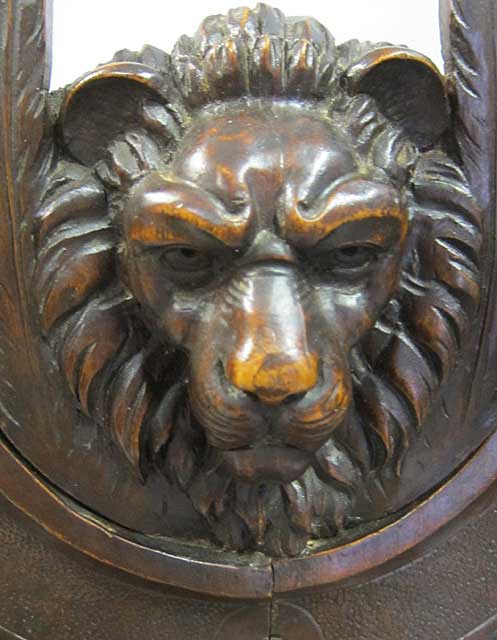

Below the pediment are arcs of scrollwork forming a platform on which putti sit, blowing into horns. Unlike Rosso's putti in the Galerie, these do not have wings. We can speculate as to why not, but will rely on conventional wisdom that putti do not have to have wings so long as they are otherwise cherubic. As with the lion's mane, the intricate carving of the hair on the head of each putto is precise yet exuberant.
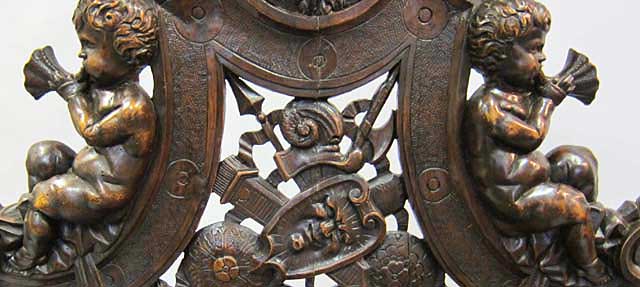
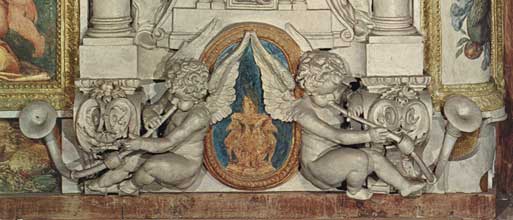
Rather than actual musical instruments, the horns played by the putti resemble more closely the horns of plenty seen commonly in the ornamentation on Renaissance furniture (also referred to as a cornucopiaas seen on chest 1034 and the central figure of Ceres on chairs 3310). Their cheeks are puffed out, as if exhaling into the mouthpiece of the instrument to begin playing a fanfare for anyone coming to view the bench. These putti are seen in profile and do not emerge completely from the back of the chair, similar to Rosso's trumpet-playing putti from the stucco to the right of the fresco called the Sacrifice.
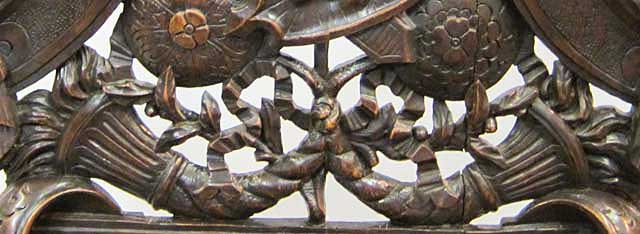
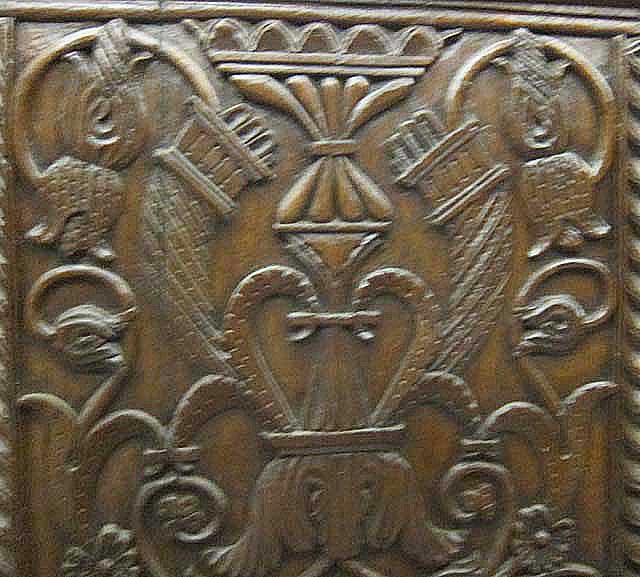
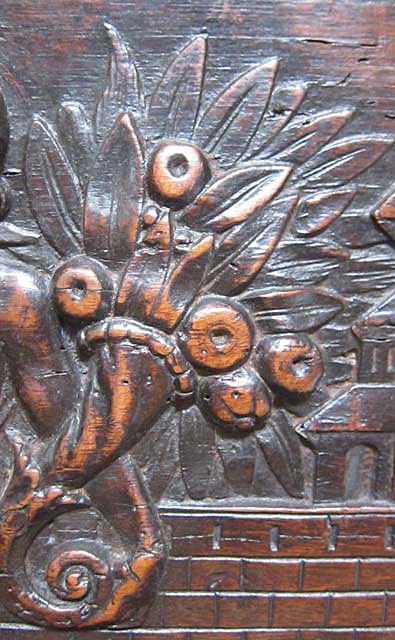
The central section of the back of the sgabello is comprised of an openwork design involving crossed armaments and shields. Such a design is often seen in Renaissance style furniture, reflecting the interest in ancient Rome and the decorative elements rediscovered there during the Renaissance. For more about these motifs, see table 9218.
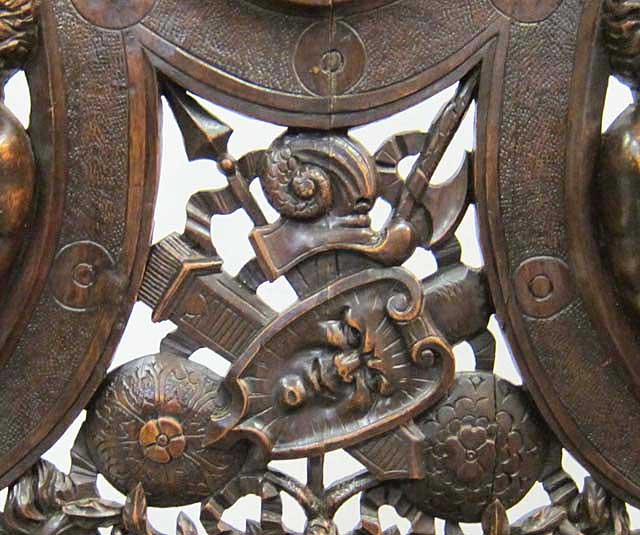
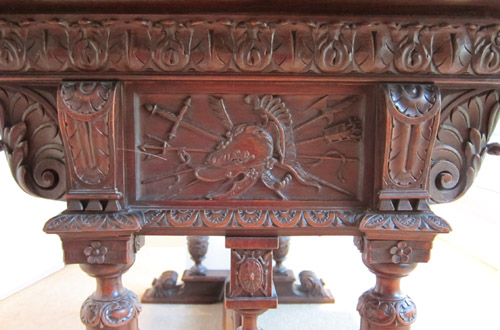
The central shield, depicted on the diagonal, includes a man's face seeming to emerge from the wood, as if floating upward out of water, with prominent eyebrows, cheeks, and chin. Perhaps this represents the visage belonging to the person who commissioned this sgabello, having a joke on all of us who have wondered about him since then.
In keeping with other sgabelli in our collection, the shape of the seat of this sgabello bench is based on a scalloped shape rich in curves and notches. However, unlike the typical sgabello seat, it does not have a circle in the center. The seat is richly carved instead of unadorned. Incised into the walnut, rather than carved from it, the ornamentation of the seat departs from the decorative vocabulary of the stuccoes in Rosso's Galerie. Rather, it harks back to the grotesque decoration based on designs rediscovered in ancient Rome by artists such as Raphael and Pinturicchio (for more about this, see our page on stylistic origins). A design based on a vase or oil lamp as the central figure was common, out of which volutes and tendrils of vegetation emerge and curl to fill the remaining space. In this case, the central design may be that of an oil lamp as what appear to be flames emerge from the top of it. The exquisite design and execution of the seat is yet another reason not to sit on the sgabello or obscure any aspect of its beauty.
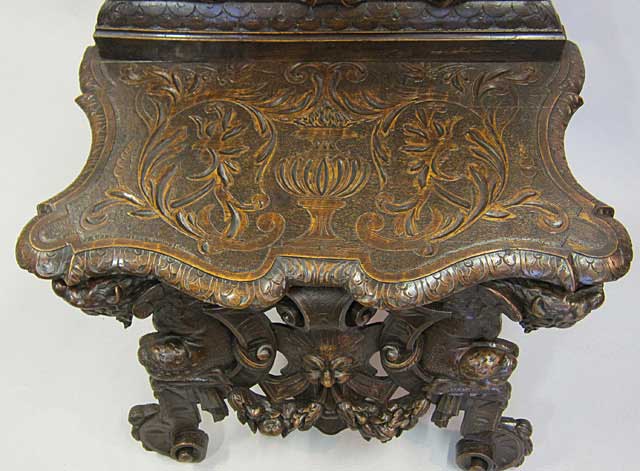
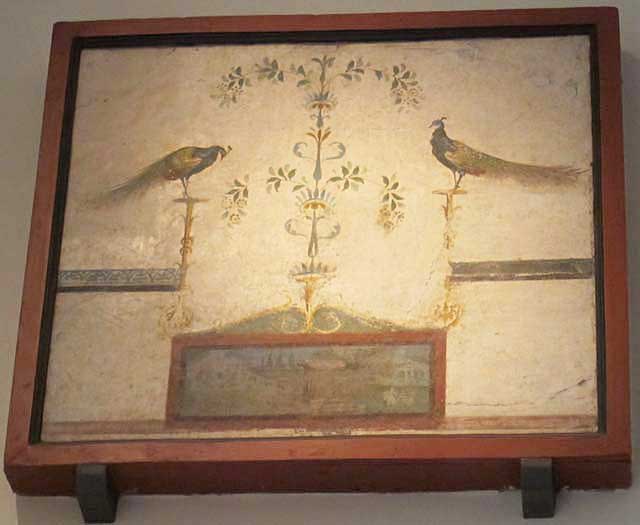
Below the seat is another complex design harking back to Rosso Fiorentino and the stuccoes in the Galerie François I. It is complex and perhaps less easy to admire than the top of the sgabello without crouching down. The central part is made up of a grotesque mask from which carved garlands of fruit and flowers emerge. As with the face portrayed on the shield at the center of the design for the upper part of the sgabello, the grotesque mask has prominent eyebrows and cheeks. And while the mouth is open, as is typical of grotesque masks, the isolation of two front teeth longer than the other teeth is unusual.
Within the frescoes of the Galerie, there are several instances of grotesque masks from which garlands emerge. These examples validate that Rosso Fiorentino was intimately familiar with the grotesque decoration developed in Rome by his younger counterpart, Raphael, who at the time the Galerie was created had already been dead for over a decade. Rendered in stucco and in a larger scale than found in Raphael's frescoes, the plasticity of Rosso's works contributes to their value as a decorative form inspiring furniture makers such as the creator of this sgabello to make it central to the base of the bench.
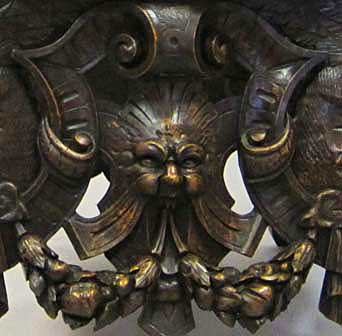
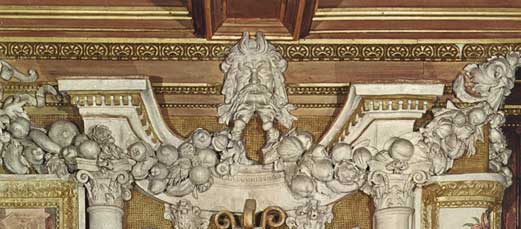
Surrounding the mask are scrollwork figures based on the strapwork (cuir découpé) designs used in several stuccoes by Rosso and based on a concept dating back to an earlier time when curled pieces of leather were attached around the edges of manuscripts. Curls are also prominent in the feet supporting the front of the chair and, on closer inspection, the strapwork that begins with scrollwork at the end of the feet, travels upward, and meets in the center atop the mask. The strapwork has a pattern of rectangles with central indentations, giving it the sense of a heavy leather band. The creator of this bench has added a lovely trompe-l'œil effect by making the garland appear to pass below the strapwork and end in a folded piece of drapery.
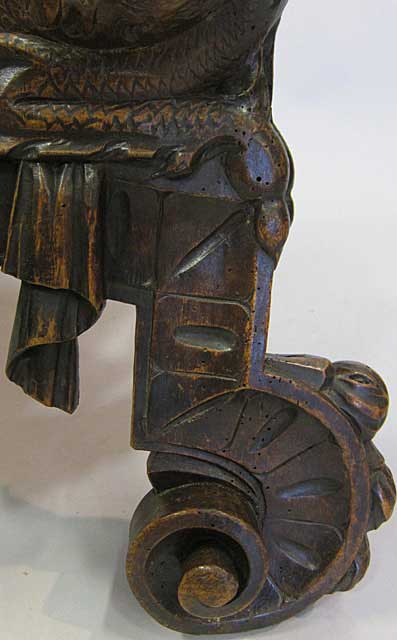
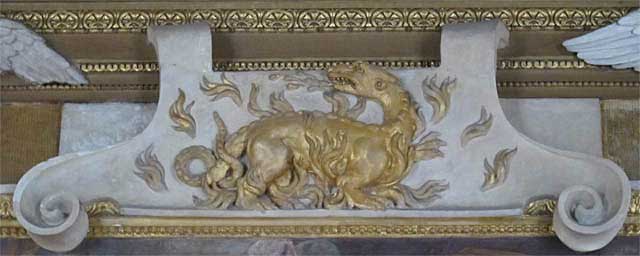
From either side of the front jut figures covered in richly sculpted hair. We assumed them to be dogs with prominent snouts and ears perked up. They appear to be crouched in the curve created by the strapwork as it angles upward from the feet at either side of the front of the sgabello. Peering below the seat of the sgabello reveals that there may be a wing extending outward from the side of the creature's body where the pattern of the carving looks more like a feather than a furry coat. A closer examination of one of the bas relief panels from the upper left side of the stucco to the left of the fresco of the Revenge of Nauplius shows a very similar figure in attack mode, identified by art historians as a harpy even though it lacks certain characteristics of this mythological female character.
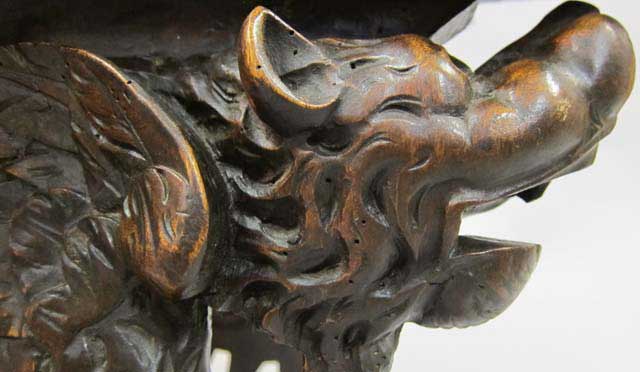
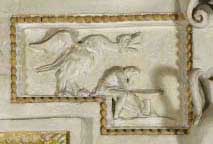
As the photo at the bottom of this page demonstrates, great care has been taken to reinforce the back of this sgabello and make it sturdy. It is in excellent condition considering its age and appears to have been well-protected over the centuries. The color of the walnut is dark with a rich patina and some lighter spots such as the foreheads and cheeks of the masks as well as the tousled hair of the putti.
Mindful that this is one of the most detailed descriptions we have written for an item in our collection, we trust that its future owner will delight as we have in what the sgabello's 19th century creator has borrowed from Rosso Fiorentino. With a nod to Eugene Carroll's verdict on Rosso's masterpiece, we share "a degree of bewilderment" when we behold this piece.
Reference
Ader-Tajan, Collection Bruno Perrier Haute Epoque (Catalog for Sale at Auction on April 6, 1992 at the Hôtel Drouot, Paris); Boccador, Jacqueline, Le Mobilier Français du Moyen Age à la Renaissance (Editions d'Art Monelle Hayot, Saint-Just-en-Chaussée, 1988); Carroll, Eugene A., Rosso Fiorentino, Drawings, Prints, and Decorative Arts (National Gallery of Art, Washington, D.C., 1987); Carroll, Eugene A., Rosso Fiorentino; Crépin-Leblond, Thierry, Le Roi et L'Artiste (Réunion des Musées Nationaux, Paris, 2013); Erlande-Brandenburg, Alain, et al, Hughes Sambin — Un Créateur au XVI Siècle (Réunion de Musées Nationaux, Paris, 2001); Salmon, Xavier, Fontainebleau — Le Temps des Italiens (Editions Snoek, Gand-Courtrai, 2013); Ward-Jackson, Peter, Some Main Streams and Tributaries in European Ornament from 1500 to 1750 (Victoria and Albert Museum, London, 1969); Zamperini, Alessandra, Ornament and the Grotesque (Thames & Hudson, London, 2008).
Uses
While it is possible to sit on this bench, why would one want to? We suggest placing it in an entryway or foyer, below mirror 9227, and admiring the pieces' shared heritage of Rosso Fiorentino at Fontainebleau.


